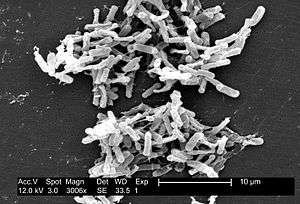Clostridium indolis
Clostridium indolis is a Gram-positive, motile, anaerobic, rod-shaped bacteria that produces terminal spores. Clostridium indolis was originally named for its ability to hydrolyze tryptophan to indole, pyruvate, and ammonia in the classic indole test which is used to distinguish bacterial species.[1] It is commonly found in soil and can be found in human and bird feces.[1] Colonies of Clostridium indolis are found to be non-hemolytic and have an optimal growth temperature of 37 °C, classifying them as mesophiles.
| Clostridium indolis | |
|---|---|
 | |
| SE micrograph of typical Clostridium colonies from a stool sample | |
| Scientific classification | |
| Kingdom: | Bacteria |
| Phylum: | |
| Class: | |
| Order: | |
| Family: | |
| Genus: | |
| Species: | C. indolis |
| Binomial name | |
| Clostridium indolis McClung and McCoy 1957 | |
Morphology
Clostridium indolis is Gram-positive, rod-shaped bacteria that occurs singly or in pairs. It has motility due to its peritrichous flagella. It produces round to oval, swollen, terminal or subterminal spores.[2] C. indolis is anaerobic, meaning it does not require oxygen. It is also a mesophile, growing best at 37 °C.
Upon plating C. indolis on blood agar, it was found that they were non-hemolytic. The morphology of the colonies was recorded as irregular, convex, translucent to opaque, white, dull granular surface, and an entire to erose margin.[2]
Genome
The genome os C. indolis DSM 775 contains 6,383,701 bp in its circular chromosome with a GC content of 44.93%.[1] Upon sequencing the genome, it was found that it contains an abundance of genes in functional groups associated with the transport and utilization of carbohydrates. The genome encodes 910 genes, including glycoside hydrolases, with the potential to degrade complex carbohydrates.
An astounding 8% of protein coding genes are related to carbohydrate transport in C. indolis. These genes are placed into two different categories: ABC (ATP binding cassette) transporters and PTS (phosphotransferase system) transporters. ABC transporters generally carry oligosaccharides and have a low affinity for hexose. PTS transporters carry a wide variety of monosaccharides and disaccharides, and have a high affinity for hexose. C. indolis contains a greater amount of PTS transporters, which are believed to be beneficial in carbohydrate limited environments.[1]
C. indolis also contains 261 genes related to energy production and conversion. Amongst these, there are genes for citrate utilization, lactate utilization, and nitrogen fixation.[1]
Ecology
C. indolis is commonly isolated from soil as well as human and bird feces. It is associated with infections of the intestinal tract.
Drug susceptibility
| Drug Name: |
|---|
| Amoxicillin/clavulanate |
| Ampicillin |
| Bacampicillin |
| Clindamycin |
| Dalbavancin |
| Doripenem |
| Ertapenem |
| Imipenem |
| Lincomycin |
| Linezolid |
| Meropenem |
| Metronidazole |
| Nitazoxanide |
| Penicillin |
| Piperacillin/tazobactam |
| Pristinamycin |
| Quinupristin-Dalfopristin |
| Teicoplanin |
| Telavancin |
| Tigecycline |
| Trovafloxacin |
References
- Biddle, A. S.; M. Huntemann, J. Han; Chen; et al. (18 March 2014). "The Complete Genome Sequence of Clostridium Indolis DSM 755 (T.)". Standards in Genomic Sciences. 9 (3): 1089–104. doi:10.4056/sigs.5281010. PMC 4149025. PMID 25197485.
- "Clostridium Indolis". ABIS Encyclopedia. 11 November 2015. Retrieved 2015-12-03.
- Berger, Stephen, MD. "Clostridium Indolis." GIDEON Guide to Medically Important Bacteria. 2015 ed. Los Angeles: GIDEON Informatics, 2015. p. 525. Print.